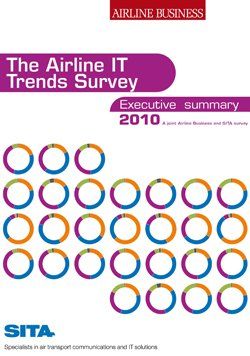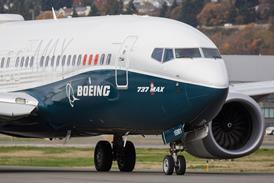Airlines are snapping up the service opportunities of mobile phones, but their attention is now also shifting towards revenue raising potential, writes Gillian Jenner in London
Excitement about mobile technology is palpable: mobile phone sales are soaring and Morgan Stanley predicts that mobile Internet will be bigger than desktop Internet by 2015. This frenzy is reflected in the 2010 Airline IT Trends Survey, which reveals that by the end of 2011 most airlines will offer mobile phone check-in, bar coded boarding passes and flight status updates.
At the moment, most airlines are using mobile services to deliver passenger processing and self-service efficiencies. Revenue generation is a longer-term goal, but savvy operators are already seizing these opportunities. In the future, airlines will be looking to further simplify the passenger journey and engage with customers in real-time, as they travel. But rolling out mobile innovations is no simple feat, not least because of the overwhelming speed with which the mobile market and technology is transforming.
Specialist IT research and advisory company Gartner says worldwide mobile phone sales increased 17% in the first quarter of this year. Sales of smart phones, which now represent 17.3% of the total, have experienced a massive 48.7% growth surge. Gartner predicts that consumers will spend $6.2 billion in mobile application stores this year.
EXECUTIVE SUMMARY |
 |
Download the executive summary of the Airline Business/SITA 2010 Airline IT Trends Survey here. |
Chief information officer Lise Fournel hopes to have a mobile e-payment pilot up and running by the end of this year. She adds: "We have an Air Canada Vacations subsidiary and we're looking at the cost of offering deals of the week, as well as searching and booking vacations on mobile. We also have a cargo business and we are looking at cargo notifications by mobile."
A more recent adopter, Virgin Blue, has launched bookings, flight changes, cancellations, check-in and 2D boarding passes by mobile. It has also unveiled a BlackBerry app aimed squarely at business travellers, which has already clocked up more than 6,000 downloads.
Beyond this, it has plans to add in-flight tracking, timetables, loyalty programme and mobile marketing services. "Our aim is to provide a single platform to help guests manage their entire travel journey," says the airline.
A suite of web services gives an airline traction, enabling it to grow revenues. All Nippon Airways customers can use their mobile to make domestic and international bookings, assign seats, change or cancel reservations, make hotel bookings and redeem award miles. They can also play games on their mobiles that allow them to accrue points, shop and access some specialised content.
"These services generate over ¥40 billion ($437.6 million), which accounts for about 15% of our internet sales, and we expect this to grow," says Naoaki Takayanagi, senior manager, consumer sales and marketing. ANA's priority, and challenge, is to drive more customers to use mobile services and turn them into repeat customers.
AirAsia is already using promotional tools to drive sales via its mobile services. A promotion in May, bookable by mobile and online channels, delivered hundreds of thousands of Malaysian ringgit booking revenue during just one day of the campaign. Meanwhile, take-up of its flight booking, seat selection, check-in and flight status services is about 1-2%. But by the year-end, when iPhone, BlackBerry and Android apps will be added, AirAsia hopes to achieve a double-digit take-up rate.
SNATCHING TIME
Regional head of innovation, commercial and technology, Lau Kin Choy is aiming for the customer experience on mobile to be similar to AirAsia.com and, by the third quarter, the ability to purchase food, insurance and baggage will be added, along with the ability to change bookings.
"Similar to how we drive people to the Internet with low fares etc, we need to find ways to move them to use mobile gadgets," Choy explains. "Nothing beats having the ability to perform all the transactions you need via a mobile phone in our busy schedules. We want our guests to use this as a lifestyle tool and not another e-commerce application."
But is this really extra revenue and not just a switching from one sales channel to another? Gerry Samuels, executive director at Mobile Travel Technologies, which developed the mobile airline platform used by both Virgin Blue and AirAsia, is convinced mobile is attracting new spend.
WATCH THE WEBCAST |
|---|
Air Transport 2010 IT Summit: The next digital decade - watch the webcast here |
There is an increasing segment of busy people who are confident booking on mobile and snatching opportunities to do so. "If you think how people use BlackBerries for e-mail when they have spare time before meetings, in the same way people are using dead time to make bookings," says Samuels.
The conundrum for marketers and chief information officers making the business case for investment in mobile technologies is that those juicy extra revenues can require a chunk of money to access them. Web platforms such as Android, iPhone, Symbian, BlackBerry and Windows Mobile have no commonality and will each require a dedicated app if you want your airline's mobile services to work natively on the device, such as putting a flight itinerary into the phone calendar.
SITA chief technology officer and head of SITA Labs, Jim Peters highlights the magnitude of the problem. He estimates that an all-singing app with drag-and-drop seat maps, credit card payment and access to loyalty points could cost $1 million per platform. The cost halves if you use a web browser, but then you cannot interact with other applications on the phone.
However, technology providers are looking at ways to overcome these barriers. Peters says there is some movement towards exploring phone application programme interfaces on the browser. Over at Amadeus, vice-president product development, sales and e-commerce platforms, Denis Lacroix sees an opportunity for Altea to offer a suite of functionality for mobile devices on a white label basis. "It is not something we can make money with, but it's the cost of doing business," he says.
TECHNOLOGY TRIALS
Providers already have their eye on the next level of innovation - interacting with passengers during their journeys. Amadeus and one of its airline partners are close to piloting a project where a permanent boarding pass will be stored on passenger mobiles. The phone is swiped to look up the itinerary, retrieve the flight details and check the passenger is boarding the correct flight.
SITA has just launched a service on British Airways' all-business class flights between London City Airport and New York that turns the mobile into a portal when you switch it on in-flight; delivering information that dynamically matches your flight and day of travel.
"We have a broad vision of a customer journey portal which says 'across this journey there is something you want to do' and the phone should be able to figure out and call up content based on your contact," says Peters. He adds that SITA is talking to corporate travel groups which want to provide dynamic content to people as they travel
The question is will airlines buy into this or will they see it as one degree too many away from their core business?
Source: Airline Business























